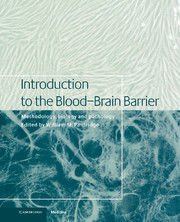Book contents
- Frontmatter
- Contents
- List of contributors
- 1 Blood–brain barrier methodology and biology
- Part I Methodology
- 2 The carotid artery single injection technique
- 3 Development of Brain Efflux Index (BEI) method and its application to the blood–brain barrier efflux transport study
- 4 In situ brain perfusion
- 5 Intravenous injection/pharmacokinetics
- 6 Isolated brain capillaries: an in vitro model of blood–brain barrier research
- 7 Isolation and behavior of plasma membrane vesicles made from cerebral capillary endothelial cells
- 8 Patch clamp techniques with isolated brain microvessel membranes
- 9 Tissue culture of brain endothelial cells – induction of blood–brain barrier properties by brain factors
- 10 Brain microvessel endothelial cell culture systems
- 11 Intracerebral microdialysis
- 12 Blood–brain barrier permeability measured with histochemistry
- 13 Measuring cerebral capillary permeability–surface area products by quantitative autoradiography
- 14 Measurement of blood–brain barrier in humans using indicator diffusion
- 15 Measurement of blood–brain permeability in humans with positron emission tomography
- 16 Magnetic resonance imaging of blood–brain barrier permeability
- 17 Molecular biology of brain capillaries
- Part II Transport biology
- Part III General aspects of CNS transport
- Part IV Signal transduction/biochemical aspects
- Part V Pathophysiology in disease states
- Index
5 - Intravenous injection/pharmacokinetics
from Part I - Methodology
Published online by Cambridge University Press: 10 December 2009
- Frontmatter
- Contents
- List of contributors
- 1 Blood–brain barrier methodology and biology
- Part I Methodology
- 2 The carotid artery single injection technique
- 3 Development of Brain Efflux Index (BEI) method and its application to the blood–brain barrier efflux transport study
- 4 In situ brain perfusion
- 5 Intravenous injection/pharmacokinetics
- 6 Isolated brain capillaries: an in vitro model of blood–brain barrier research
- 7 Isolation and behavior of plasma membrane vesicles made from cerebral capillary endothelial cells
- 8 Patch clamp techniques with isolated brain microvessel membranes
- 9 Tissue culture of brain endothelial cells – induction of blood–brain barrier properties by brain factors
- 10 Brain microvessel endothelial cell culture systems
- 11 Intracerebral microdialysis
- 12 Blood–brain barrier permeability measured with histochemistry
- 13 Measuring cerebral capillary permeability–surface area products by quantitative autoradiography
- 14 Measurement of blood–brain barrier in humans using indicator diffusion
- 15 Measurement of blood–brain permeability in humans with positron emission tomography
- 16 Magnetic resonance imaging of blood–brain barrier permeability
- 17 Molecular biology of brain capillaries
- Part II Transport biology
- Part III General aspects of CNS transport
- Part IV Signal transduction/biochemical aspects
- Part V Pathophysiology in disease states
- Index
Summary
Introduction
Measurement of brain uptake rates after intravenous (i.v.) administration of a test substance followed by sampling of brain tissue has been the most widely used approach compared to other techniques for measuring the permeability of the blood–brain barrier (BBB). In contrast to single-passage methods such as the brain uptake index (BUI) and to the indicator dilution technique, brain uptake in i.v. experiments is measured after multiple passages through the capillary bed and offers the highest potential sensitivity of the available techniques. However, the apparent experimental simplicity may mislead the investigator about the fact that the obtained data are readily misinterpreted. Awareness of potential pitfalls associated with the method is required to avoid mistakes in the experimental protocol and evaluation that could distort the results. The purpose of this chapter is to briefly introduce aspects of pharmacokinetic evaluations and highlight specific advantages and disadvantages of the intravenous approach, with examples.
Technically, measurement of brain uptake typically involves injection of the test compound as a radiolabeled tracer in physiological solution as an i.v. bolus. Radiolabeling is not required if sufficiently sensitive analytical methods are available for measuring the substance under investigation in plasma and tissue. Corresponding to the species in which the study is performed, the injected volume should be sufficiently small compared to the total intravascular volume not to introduce a systematic error.
- Type
- Chapter
- Information
- Introduction to the Blood-Brain BarrierMethodology, Biology and Pathology, pp. 41 - 48Publisher: Cambridge University PressPrint publication year: 1998



